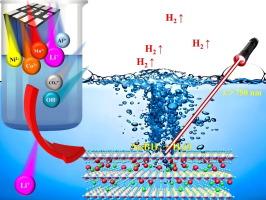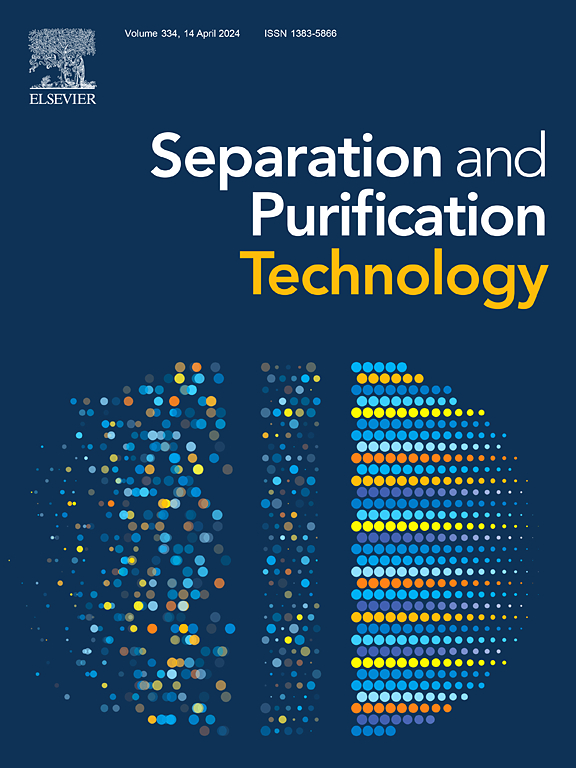将废旧 LiNi1-x-yMnxCoyO2 阴极回收为高熵 NiCoMnAlFe-LDH,通过 NaBH4 水解实现可控制氢
IF 8.1
1区 工程技术
Q1 ENGINEERING, CHEMICAL
引用次数: 0
摘要
从废旧锂离子电池中回收有毒金属阳离子并对其进行环保应用是一项全球性的环境挑战。本研究利用层状双氢氧化物(LDHs)结构的高容错性,从废镍钴锰酸锂正极和废液中合成了高熵的镍钴锰铝铁-LDHs,实现了有毒金属阳离子的高效回收。所获得的高熵镍钴锰铝铁-LDHs 在红外辐射的驱动下具有快速光热转化能力,能在催化剂表面产生局部高温,快速催化 NaBH4 溶液水解产生氢气。在 1050 纳米红外激光照射的驱动下,氢气进化速率达到 1.72 mol-h-1-g-1-W-1。关闭光源后,NaBH4 的水解反应立即停止,从而实现了 NaBH4 氢气释放的可控性,有效解决了 NaBH4 作为氢气载体的科学难题。这项研究为废锂电池的回收和危险材料的绿色利用提供了一种新方法。本文章由计算机程序翻译,如有差异,请以英文原文为准。

Recycling spent LiNi1-x-yMnxCoyO2 cathodes to high-entropy NiCoMnAlFe-LDHs for controllable hydrogen generation via NaBH4 hydrolysis
The recycling and environmentally friendly application of toxic metal cations from spent lithium-ion batteries is a global environmental challenge. This study utilizes the high structural tolerance of layered double hydroxides (LDHs) to synthesize high-entropy NiCoMnAlFe-LDHs from spent LiNi1-x-yMnxCoyO2 cathodes and liquid wastes, achieving efficient recovery of toxic metal cations. The obtained high-entropy NiCoMnAlFe-LDHs demonstrated rapid photo-thermal conversion capability driven by infrared radiation, generating localized high temperature on the surface of catalyst and rapidly catalyzing the hydrolysis of NaBH4 solution for hydrogen evolution. The hydrogen evolution rate reaches 1.72 mol·h−1·g−1·W−1 driven by 1050 nm infrared laser irradiation. The hydrolysis reaction of NaBH4 ceases immediately upon turning off the light source, allowing for controllable hydrogen release from NaBH4 and effectively solve the scientific challenges for NaBH4 as hydrogen carrier. This study offers a new approach for the recycling of spent lithium battery and the green utilization of hazardous materials.
求助全文
通过发布文献求助,成功后即可免费获取论文全文。
去求助
来源期刊

Separation and Purification Technology
工程技术-工程:化工
CiteScore
14.00
自引率
12.80%
发文量
2347
审稿时长
43 days
期刊介绍:
Separation and Purification Technology is a premier journal committed to sharing innovative methods for separation and purification in chemical and environmental engineering, encompassing both homogeneous solutions and heterogeneous mixtures. Our scope includes the separation and/or purification of liquids, vapors, and gases, as well as carbon capture and separation techniques. However, it's important to note that methods solely intended for analytical purposes are not within the scope of the journal. Additionally, disciplines such as soil science, polymer science, and metallurgy fall outside the purview of Separation and Purification Technology. Join us in advancing the field of separation and purification methods for sustainable solutions in chemical and environmental engineering.
 求助内容:
求助内容: 应助结果提醒方式:
应助结果提醒方式:


